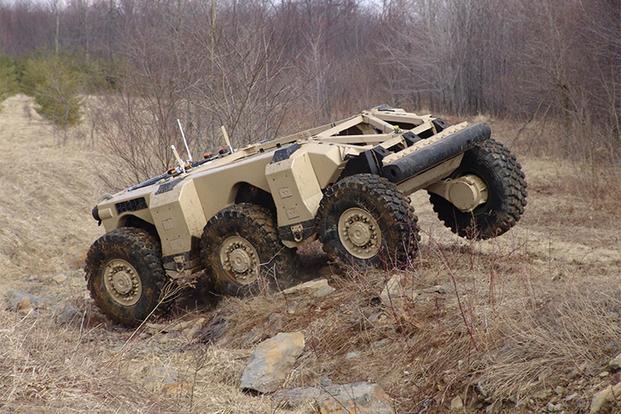In an effort to make robotics a reality inside its combat formations, the U.S. Army is planning on testing the first prototypes of the Robotic Combat Vehicle by 2021.
"The Army has realized that robotics is going to be critical for our success in the future," Col. William T. Nuckols, director of the newly formed Training and Doctrine Command Project Office for Maneuver Robotics and Autonomous Systems, told Military.com recently.
"We are going to build some tech demonstrators of the Robotic Combat Vehicle and actually get it into the hands of soldiers, ideally between 2020 and 2021," Nuckols said.
These early prototypes will be built from the Army's legacy vehicle platforms, but they "will likely not look like the legacy vehicle," he said.
"The reason you don't want to take ... let's say an Abrams tank," Nuckols said. "Abrams is close to 80 tons now and has a significant sustainment burden. You don't want to have to pay for all of that weight and force protection when you don't have soldiers in the vehicle that you need to protect.
"You could have the same capability on a 25-ton vehicle and potentially have the same lethality as an Abrams," he said.
TRADOC'S Project Office for Maneuver Robotics and Autonomous Systems, or TPO-MRAS, falls under Fort Benning, Georgia's Capabilities Development and Integration Directorate. The new office is supporting the Army's new Cross Functional Team for the Next Generation Combat Vehicle in the Robotic Combat Vehicle effort.
The new robotic prototypes will have all the equipment necessary to make them semi-autonomous, so they can maneuver for short distances and engage targets, Nuckols said.
The effort will be no doubt be challenging, he said, pointing to the recent advances in self-driving cars.
"That is not easy, and that is in a fairly pristine environment with well-defined roads," Nuckols said. "When you take it to that step of combat, which is probably that most chaotic thing that mankind does, that is a whole new ballgame ... especially when you are talking about blowing things up and killing people. You have to be very careful."
The tech demonstrators of the first Robotic Combat Vehicles will be the first step in a long learning process, he said.
"It will be a chance to both test our ability to build a Robotic Combat Vehicle in terms of technology, and it's also going to be an opportunity to assess how the soldiers would use that capability," Nuckols said. "So it will be an operational test as well as a technical test."
If all goes well, "we are looking at potentially building a number of purpose-built Robotic Combat Vehicles sometime immediately following that 2021 experiment," he said.
Critics will argue that the effort resembles the Army's failed Future Combat Systems, an ambitious effort to design a new fleet of lightweight manned and unmanned combat vehicles and other platforms to completely dominate future battlefields, Nuckols said.
But the technology FCS depended on simply did not exist. The Army spent billions on FCS, only to see it fail when then-Defense Secretary Robert Gates killed the 27-ton Manned Ground Vehicles portion of FCS in the 2010 budget while criticizing the advanced design as ill-suited to survive current battlefield threats.
"That was a long time ago, and technology has changed a lot ... and we are trying to glean the things we learned in the past," Nuckols said.
"One of the critical underlying failures of FCS was the theory that you would be able to always see the enemy; that is just not possible. You are not always going to find the enemy first, no matter how good your sensors are and I think the Army understands that," he said. "You can't just always assume that you can have a lighter, less protected vehicle and be able to pick and choose exactly when and how you engage the enemy."
Building combat-ready, robotic vehicles will depend on the lessons learned during the experiments with the tech demonstrators in 2021, Nuckols said.
"We will leverage those technical and operational lessons to guide us in phase two of the operation which is the purpose-built Robotic Combat Vehicle," he said.
"The key thing is, if we don't start, we are never going to get there. Our initial efforts might not meet the expectations of a lot of folks out there, but we've got to start somewhere to learn and improve to get where we know we need to go," Nuckols said.
-- Matthew Cox can be reached at matthew.cox@military.com.











